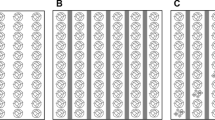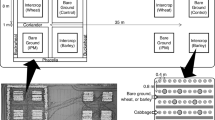Abstract
Lepidopteran stem borers are the main pests of cereals in Ethiopia. In recent years, habitat management techniques, which aim at increasing plant biodiversity through mixed cropping, have gained increased attention in stem borer control. In the present study, the profitability of mixed cropping of maize with haricot beans at different ratios and the effect on infestation of maize by stem borers, yield and borer parasitism were studied in Melkassa and Mieso, Ethiopia, in a field experiment under natural infestation. In Melkassa, pest infestations were too low for the cropping system to affect pests, plant damage and yields significantly, whereas in Mieso, where the pest densities were high, intercropping of maize with beans at ratios of 1:1 to 2:1 significantly decreased borer densities compared with pure maize stands. Chilo partellus (Swinhoe) and Cotesia flavipes. (Cameron) were the major stem borer and parasitoid species, respectively, recorded both at Melkassa and Mieso. Borer parasitism was higher at Mieso than at Melkassa and tended to increase with the increase of the haricot bean ratio in the intercropping system. Land equivalent ratios of >1 indicated higher land use efficiency in mixed compared with sole cropping, even if pest densities were low.
Similar content being viewed by others
References
Ajala, S. O., Kling, J. G., Schulthess, F., Cardwell, K., & Odiyi, A. (2001). Progress in breeding for resistance to maize stem borers Sesamia calamistis and Eldana saccharina in West and Central Africa. In Proc. Seventh Eastern and Southern Africa Regional Maize Conference (Nairobi, Kenya), pp. 49–54.
Amoako-Atta, B., Omolo, E. O., Atta, B., & Amoak, A. D. (1983). Influence of maize, cowpea and sorghum intercropping systems on stem-/pod-borer infestations. Insect Science and Its Application, 4, 47–57.
Bosque-Pérez, N. A., Kling, J. G., & Odubiyi, S. I. (1997). Recent advances in the development of sources of resistance to pink stalk borer and African sugarcane borer. In: J. Mihm (Eds.), Insect resistant maize: Recent advances and utilization. Proc. of an International Symposium (pp. 234–240). Mexico City, Mexico: CIMMYT.
Chabi-Olaye, A., Nolte, C., Schulthess, F., & Borgemeister, C. (2005a). Relationship of intercropped maize, stem borer damage to maize yield and land-use efficiency in the humid forest of Cameroon. Bulletin of Entomological Research, 95, 1–11.
Chabi-Olaye, A., Nolte, C., Schulthess, F., & Borgemeister, C. (2005b). Effects of grain legumes and cover crops on maize yield and plant damage by Busseola fusca (Fuller) (Lepidoptera: Noctuidae) in the humid forest of southern Cameroon. Agriculture, Ecosystems & Environment, 108, 17–28.
CSA (Central Statistical Authority) (1997) Agricultural sample survey 1996/97: Report on area and production for major crops (Private peasant holdings, Meher season). Statistical Bull. No. 171. CSA, Addis Ababa, Ethiopia.
Emana, G., & Tsedeke, A. (1990). Management of maize stem borer using sowing date at Arsi-Negele. Pest Management Journal of Ethiopia, 3, 47–52.
Gashawbeza, A., & Melaku, W. (1995). Loss caused by the stalk borers, Chilo partellus (Swinhoe) and Busseola fusca (Fuller) in central Ethiopia. In 3rd Annual Conference of Crop Protection Society of Ethiopia (Addis Ababa, Ethiopia).
Getu, E. (2002). Ecological analysis of stem borers and their natural enemies under maize and sorghum based agro-ecosystem in Ethiopia. Ph.D. thesis, Kenyatta University, Nairobi, Kenya.
Getu, E., Overholt, W. A., & Kairu, E. (2001). Distribution and species composition of stem borers and their natural enemies in maize and sorghum in Ethiopia. Insect Science and Its Application, 21, 353–359.
Kaufmann, T. (1983). Behavioural biology, feeding habits and ecology of three species of maize stem borers: Eldana saccharina (Lepidoptera: Pyralidae), Sesamia calamistis and Busseola fusca (Noctuidae) in Ibadan, Nigeria, West Africa. Journal of the Georgia Entomological Society, 18, 259–272.
Khan, Z. R., Picket, J. A., Wadhams, L., & Muyekho, F. (2001). Habitat management strategies for the control of cereal stem borers and striga in maize in Kenya. Insect Science and Its Application, 21, 375–380.
Mead, R., & Willey, R. W. (1980). The concept of a ‘land equivalent ratio’ and advantages in yield from intercropping. Experimental Agriculture, 16, 217–218.
Ndemah, R., Gounou, S., & Schulthess, F. (2002). The role of wild grasses in the management of lepidopterous cereal stem borers on maize in the forest zone of Cameroon and the derived savanna of southern Benin. Bulletin of Entomological Research, 92, 507–519.
Nye, I. W. R. (1960). The insect pests of graminaceous crops in East Africa. Colonial Research Studies, 31, 1–48.
Omwega, C. O., Muchugu, E., Overholt, W. A. and Schulthess, F. (2006). Release and establishment of Cotesia flavipes (Hym., Braconidae) an exotic parasitoid of Chilo partellus (Lep., Cambridae) in East and Southern Africa. Annales de la Société Entomologique de France, 42, 511–517.
SAS Institute. (1999) SAS/Stat user’s guide. Cary, NC, USA: SAS Institute Inc.
Schulthess, F., Bosque-Pérez, N. A., Chabi-Olaye, A., Gounou, S., Ndemah, R., & Goergen, G. (1997). Exchanging natural enemies species of lepidopterous cereal stem borers between African regions. Insect Science and Its Application, 17, 97–108.
Schulthess, F., Chabi-Olaye, A., & Gounou, S. (2004). Multi-trophic level interactions in a cassava-maize mixed cropping system in the humid tropics of West Africa. Bulletin of Entomological Research, 94, 261–272.
Seshu Reddy, K. V. (1990). Cultural control of Chilo spp. in gramineous crops. Insect Science and Its Application, 11, 703–712.
Sétamou, M., Schulthess, F., Bosque-Pérez, N. A., & Thomas-Odjo, A. (1993). Effect of nitrogen and silica on the bionomics of Sesamia calamistis Hampson (Lepidoptera: Noctuidae). Bulletin of Entomological Research, 83, 405–411.
Sétamou, M., Schulthess, F., Bosque-Pérez, N. A., & Thomas-Odjo, A. (1995). Effect of stem and cob borers on maize subjected to different nitrogen treatments with special reference to Sesamia calamistis Hampson (Lepidoptera: Noctuidae). Entomologia Experimentalis et Applicata, 77, 205–210.
Sharma, H. C., Tanejak, S. L., Leuschner, K., & Nwanze, K. F. (1992). Techniques to screening sorghum for resistance to insect pests. Information Bulletin ICRISAT, India no. 32.
Vandermeer, J. (1989). The ecology of intercropping. Cambridge, UK: Cambridge University Press.
Wale, M., Schulthess, F., Kairu, E. W., & Omwega, C. O. (2006). Cereal yield losses caused by lepidopterous stem borers at different nitrogen fertilizer rates in Ethiopia. Journal of Applied Entomology, 130, 220–229.
Zhou, G., Baumgartner, J., & Overholt, W. A. (2001). Impact assessment of an exotic parasitoid on stem borer (Lepidoptera) population dynamics in Kenya. Ecological Applications, 11, 1554–1562.
Acknowledgments
We would like to thank the Ethiopian Institute of Agricultural Research (EIAR) for providing the necessary facilities. The research work was funded by the Directorate General for International Cooperation, the Netherlands, through a grant on Biological Control of Cereal Stem Borers in Subsistence Agriculture in Africa. The technical support of Mr. Abebe Zewdu is duly acknowledged.
Author information
Authors and Affiliations
Corresponding author
Rights and permissions
About this article
Cite this article
Belay, D., Schulthess, F. & Omwega, C. The profitability of maize–haricot bean intercropping techniques to control maize stem borers under low pest densities in Ethiopia. Phytoparasitica 37, 43–50 (2009). https://doi.org/10.1007/s12600-008-0002-7
Received:
Accepted:
Published:
Issue Date:
DOI: https://doi.org/10.1007/s12600-008-0002-7




